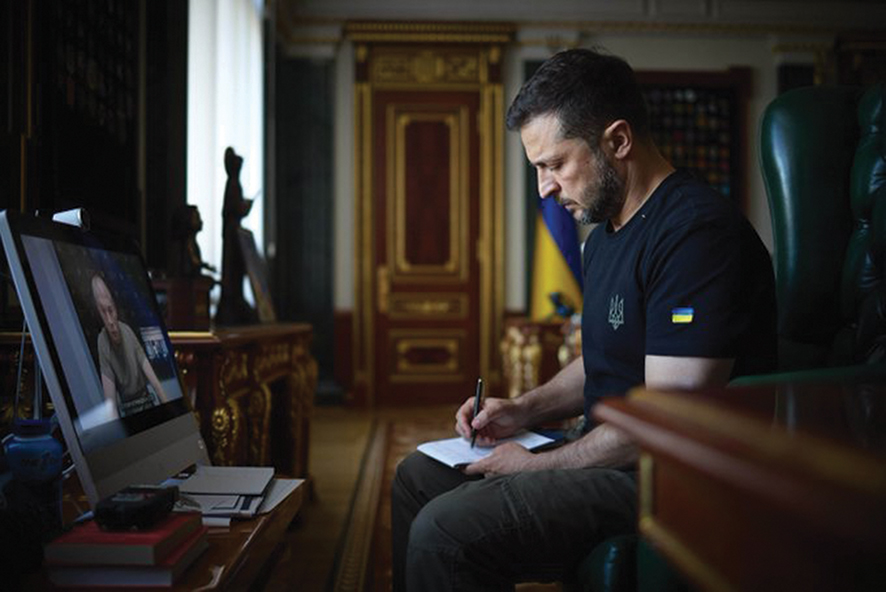The Ukrainian president on Wednesday night said his forces continue to advance in Russia’s Kursk region, and that they had moved forward between 1 and 2km in various directions since the start of the day.
“We have captured more than 100 Russian servicemen during this period,” he said. “I am grateful to everyone involved; this will accelerate our people being able to come home.”
Further, Ukraine’s overnight operation this week targeting four Russian military airfields marked its largest long-range drone raid of the war, a Ukrainian security source said.
The attack, which targeted Russia’s Voronezh, Kursk, Savasleyka and Borisoglebsk air bases, aimed to undermine Moscow’s ability to use warplanes for gliding bomb attacks on Ukraine, the source said.
The Reuters news agency said it could not immediately independently verify the claim. Ukraine was still assessing the scale of damage, the source said.

How much Russian territory does Ukraine now control?
As of Monday, Ukraine controlled at least 800sq km of territory in Russia’s Kursk region, according to an analysis by AFP using data from the Institute for the Study of War (ISW).
Ukraine’s army chief, Oleksandr Syrskii, said Kyiv controls about 1,000sq km of Kursk on Monday.
Russia has admitted that Ukrainian units have driven deep into the country, saying on Sunday they had reached as far as 30km from the border.
At least 28 Kursk villages are now under Ukraine’s control, the region’s governor reported on Monday.
Kyiv was also in control of at least the western part of Sudzha, with the central and eastern parts contested “grey zones,” ISW reported in an assessment on Monday.
Ukraine made its biggest gains in the first two days of the incursion, penetrating “at least two Russian defensive lines,” ISW said on August 7.
ISW later reported that since Russia has rushed reinforcements to the area, the rate of Ukraine’s advance into the region has slowed. Indeed, Russia is saying it has thwarted attempts by Ukrainian forces to push deeper into five areas in the Kursk region.
“The attempts by enemy mobile units using armored equipment to break through deeper into Russian territory have been repelled,” the Russian Defense Ministry said in a statement, adding its troops shot down 117 Ukrainian drones within Russian territory overnight, mostly in the Kursk, Voronezh, Belgorod and Nizhny Novgorod regions.
It said four tactical missiles had also been downed, and showed Sukhoi Su-34 bombers striking Ukrainian positions in the Kursk region.
Later, the ministry said Russian forces had repelled a series of Ukrainian attacks inside the Kursk region, including at Russkoye Porechnoye 18km from the border, and pro-Russian war bloggers said the front “had been stabilized,” while Russia’s National Guard said it was beefing up security at the Kursk nuclear power plant, located just 35km from the fighting.
Meanwhile, Zelensky is eyeing setting up military administrations in the Kursk region. He held a meeting on the security and humanitarian situation in the region following the Ukrainian military’s cross-border assault.
“Security, humanitarian aid, creation of military administrations if necessary,” he said on Telegram, posting a video of the meeting with top Ukrainian officials.
Russia ‘needs to do something very radical’ to push out Ukraine forces
Pavel Felgenhauer, the defense analyst and columnist at Novaya Gazeta, says the Kremlin is in “a bit of a dilemma” over what to do next.
During the offensive of many months in the Donbas, Russia has run out of battle-ready reserves, he told Al Jazeera, adding that in order to push Ukrainian forces out, “they need to do something very radical, and it’s not clear how that’s going to be done.”
“Of course, Moscow does not want to pull out from pieces of Donbas, which were taken back through such a loss of money and lives, to push the Ukrainians out of Kursk,” Felgenhauer said. “It’s a bit of a dilemma now for the Kremlin what comes next, and it’s a dilemma for the Ukrainians what they do next.”
US President Joe Biden agreed that it is indeed a dilemma for Russia, making comments about Russian President Vladimir Putin, and noting that he has been briefed every four to five hours for the past six to eight days on Ukraine’s incursion.
The White House said Ukraine did not provide advance notice of its planned move, and Spokesperson Karine Jean-Pierre said Washington had no involvement in the operation.
“We had nothing to do with this,” she said. “We have no involvement. We’ll continue to have conversations with the Ukrainians about their approach, but it is really for them to speak to.”
Poland receives German warrant to make arrest for Nord Stream attack
Poland’s National Public Prosecutor’s Office this week confirmed it had received a European arrest warrant by German authorities related to an attack on the Nord Stream gas pipelines.
Germany has urged Warsaw to arrest a Ukrainian diving instructor who was allegedly part of a team that blew up the pipelines two years ago, according to reports in German media.
The Polish prosecution said he was not arrested in Poland as he had left the territory for Ukraine in early July.
Source: ALJAZEERA
Compiled by Ana Dumbadze














